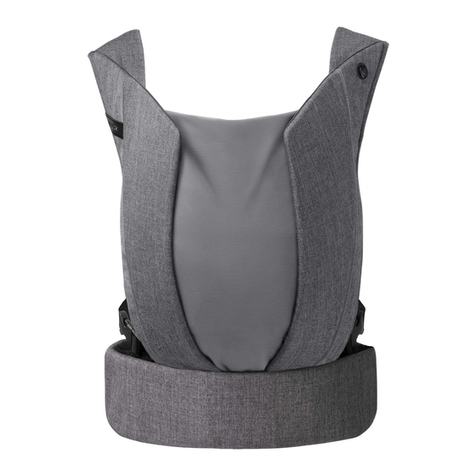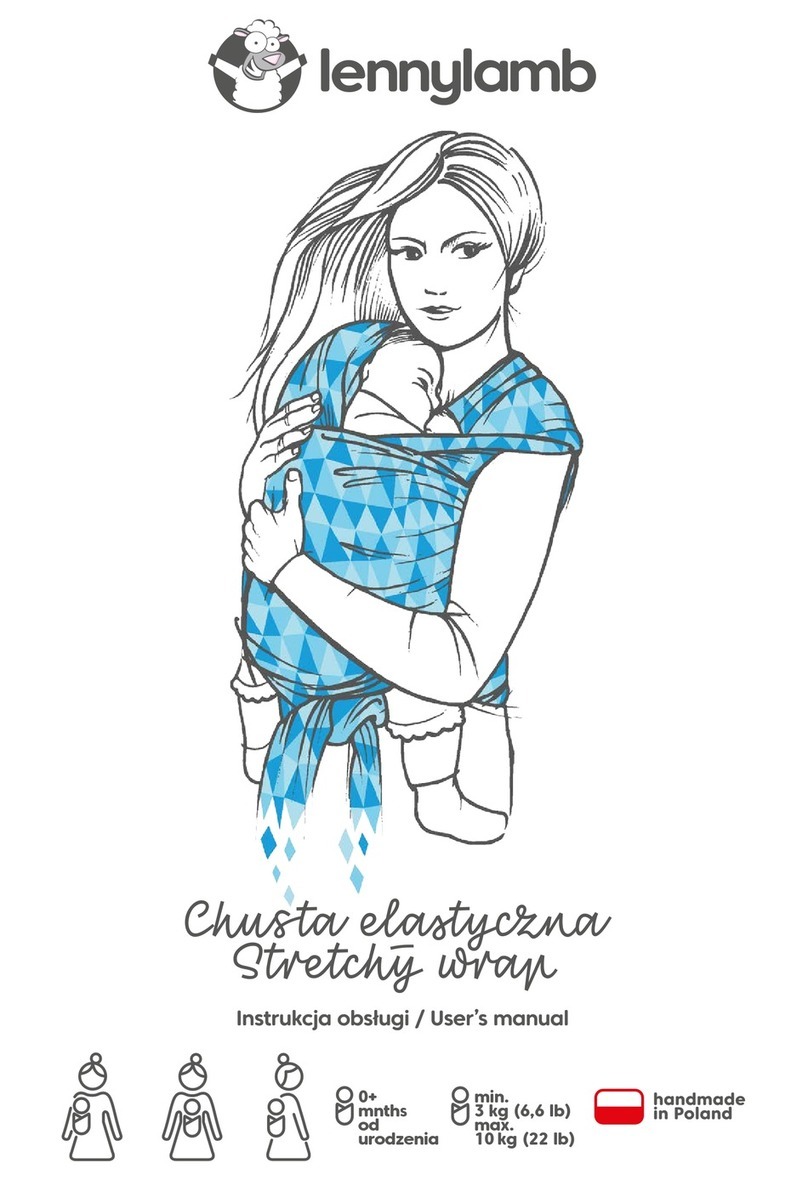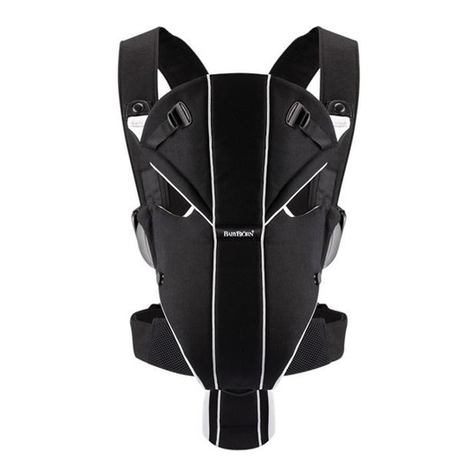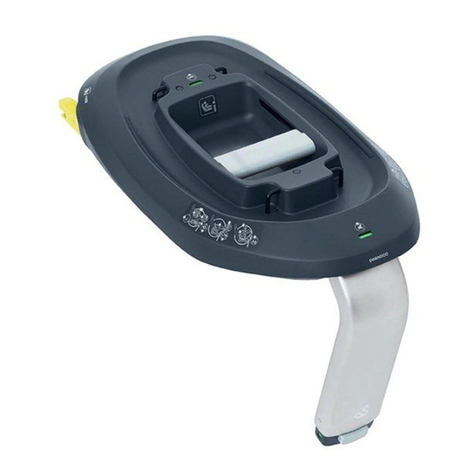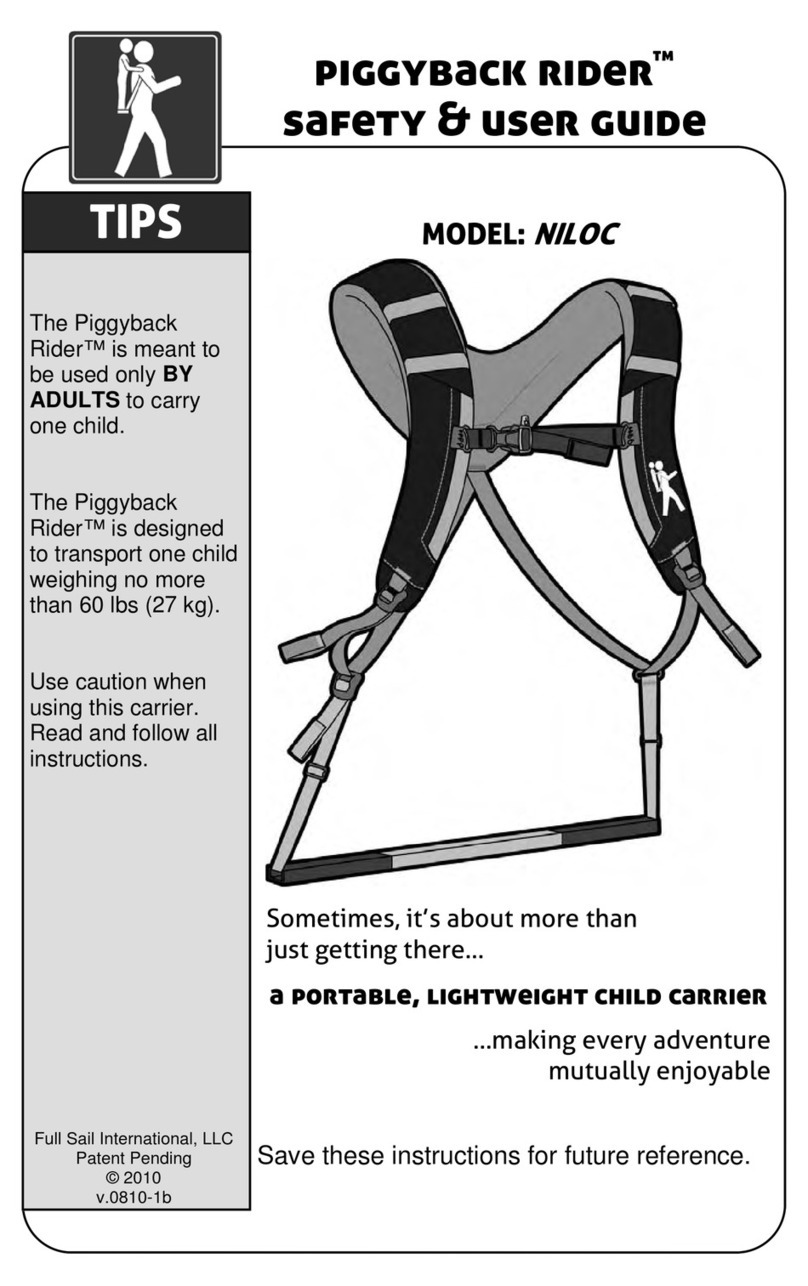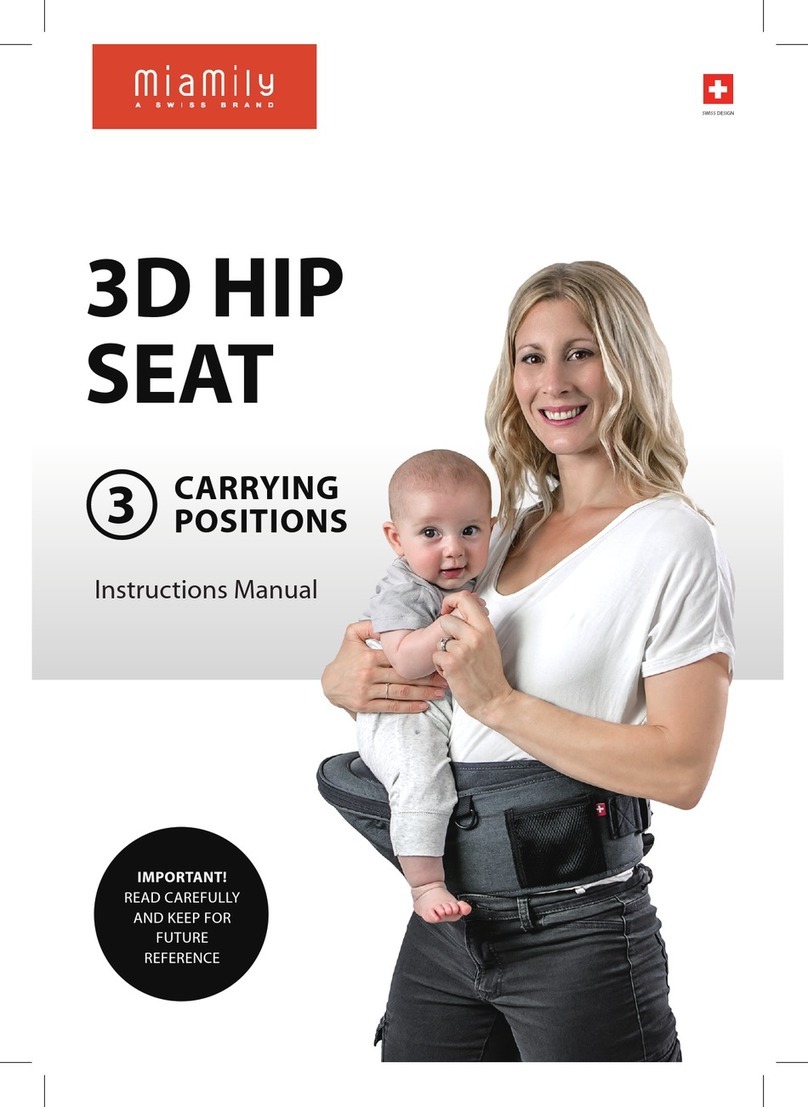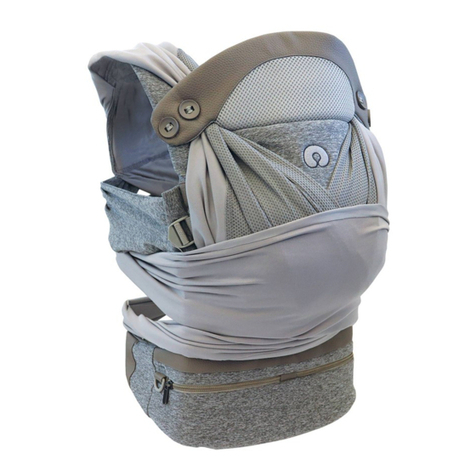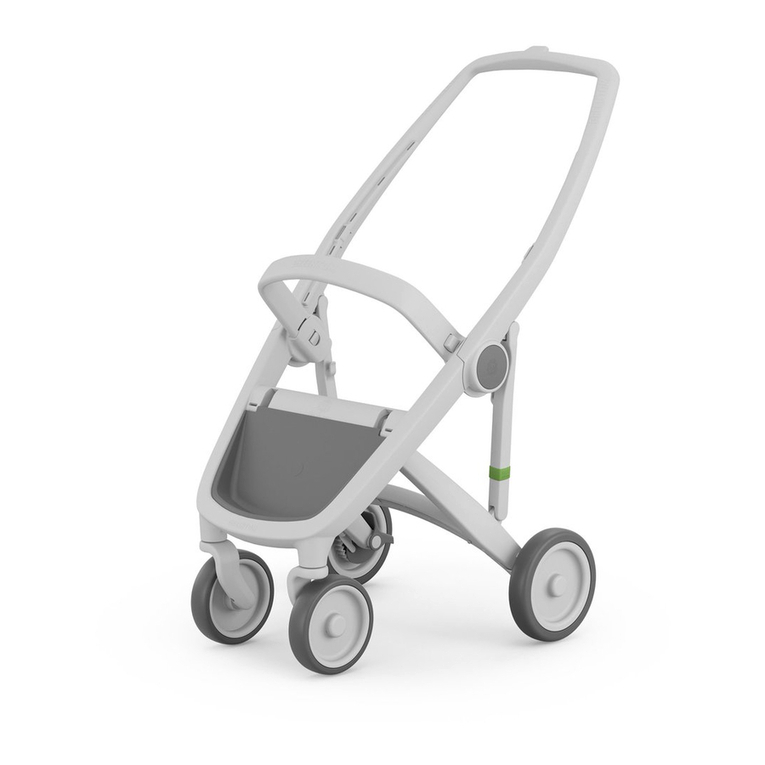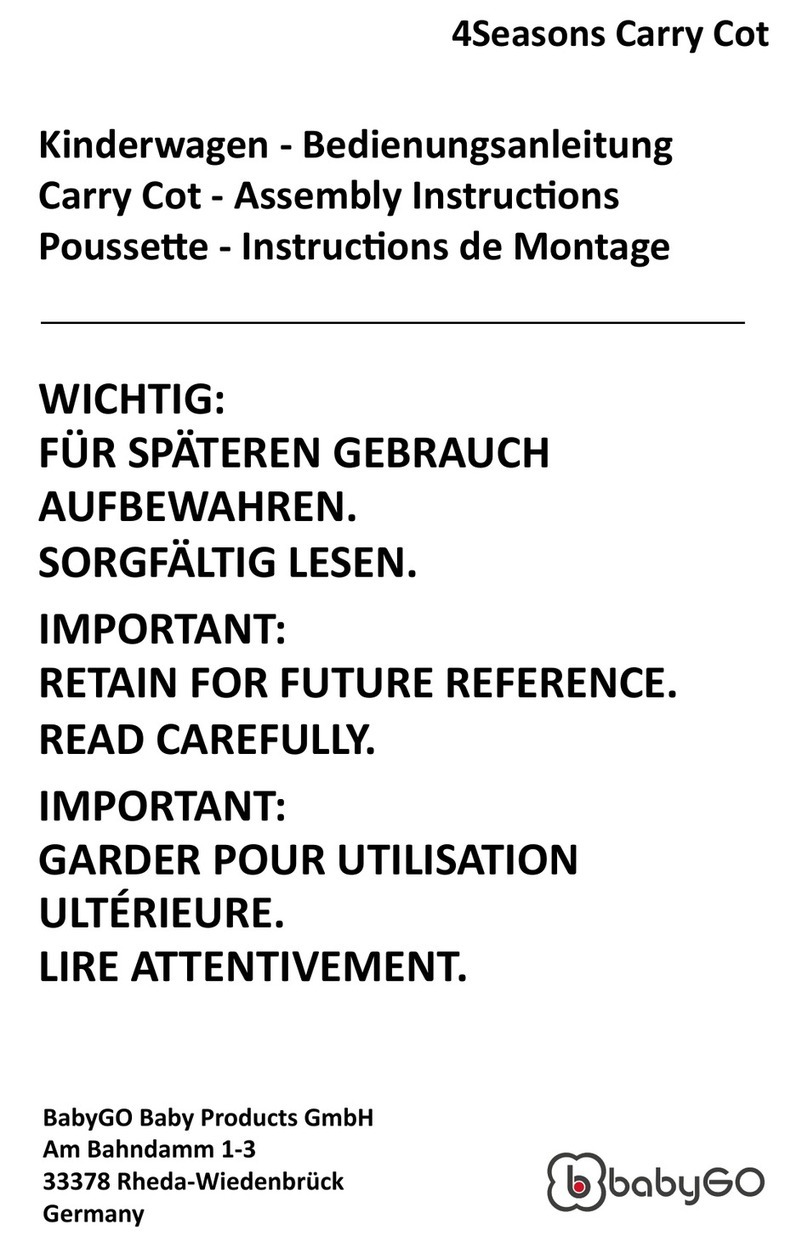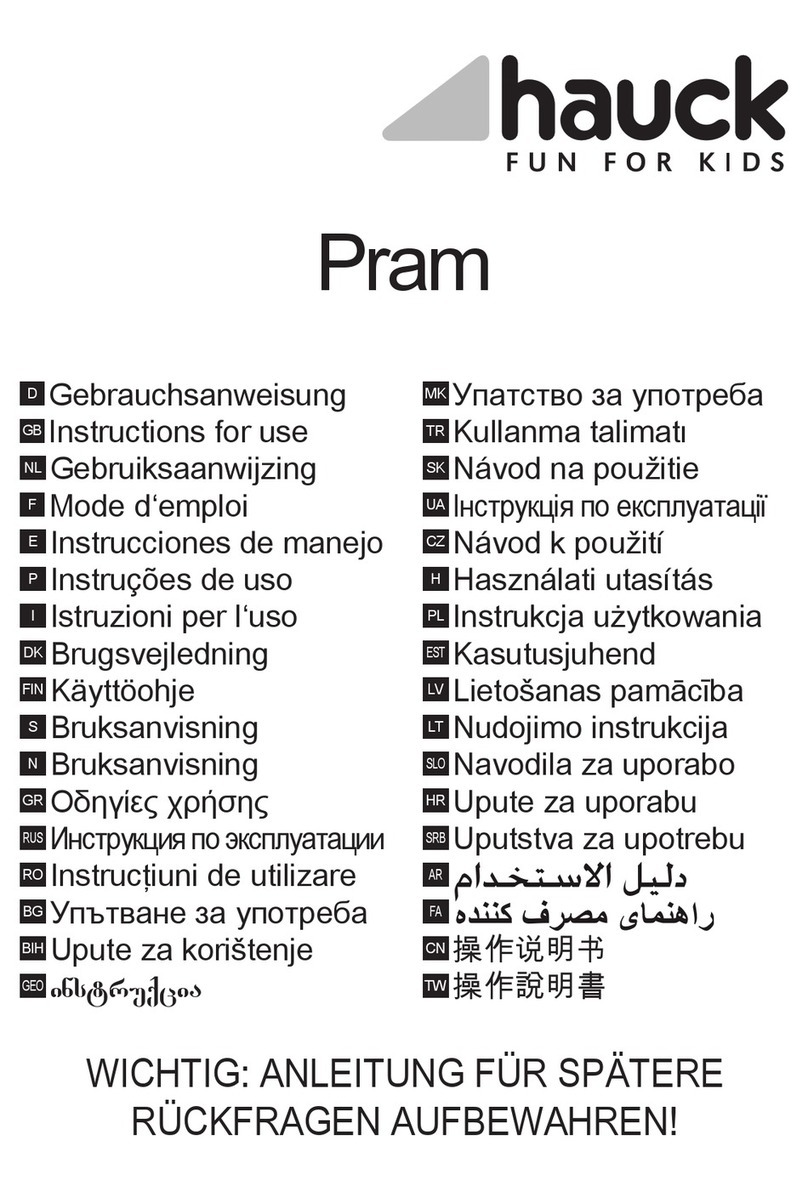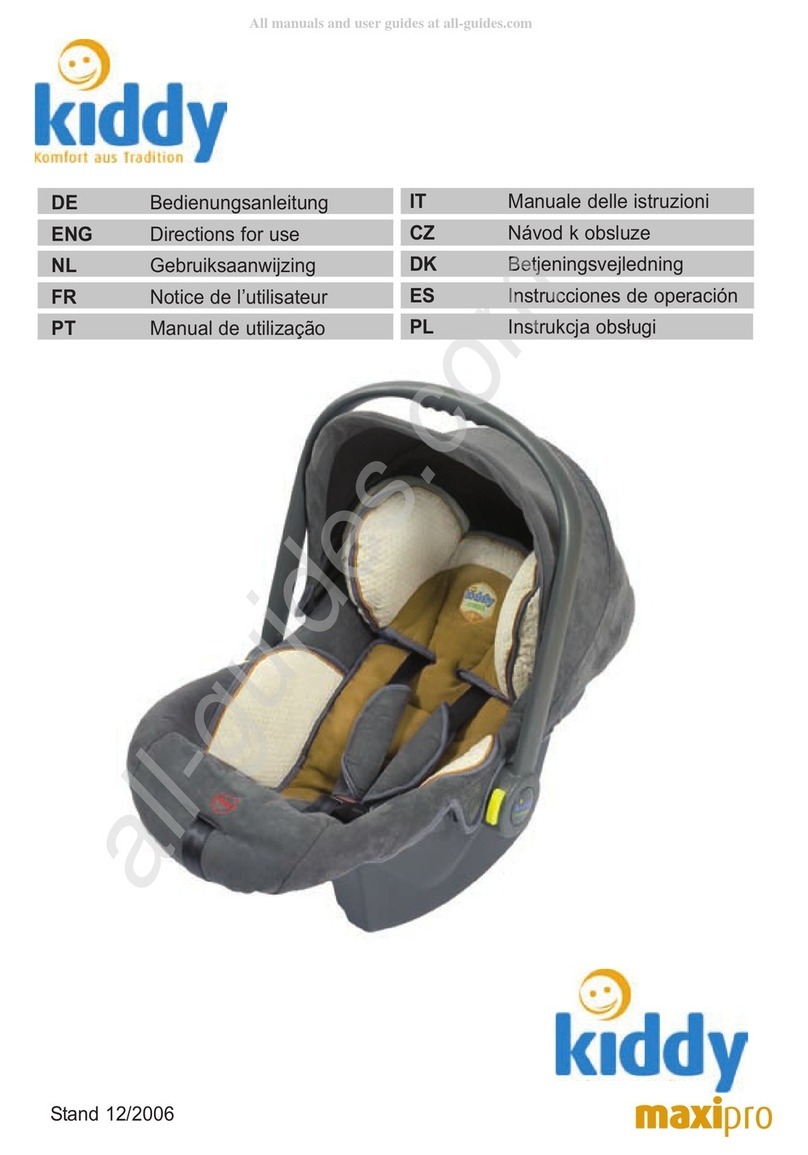Chariot Cheetah User manual

CHEETAH 1 & 2
USER GUIDE
Cheetah_Manual_English_050212.indd 1 12-09-17 3:28 PM

1 IntroductIon
1.0 Thank You 03
1.1 Manual Intended Use 04
1.2 Carrier Intended Use 04
1.3 Specications 04
2 Parts descrIPtIon
2.0 Included in the box 05
3 safety
3.0 Safety Introduction 06
3.1 Symbols and Instructions 06
3.2 General Safety Instructions 06
4 GettInG started
4.0 Unpacking Your Carrier 08
4.1 Included Components 08
4.2 Unfolding the Carrier 09
4.3 Folding the Carrier 09
4.4 Installing the Wheels 10
4.5 Removing the Wheels 10
4.6 Installing the Handlebar 11
4.7 Installing a CTSTM Conversion Kit 11
5 use & features
5.0 Setting the Parking Brake 12
5.1 Using the Two-in One Cover 13
5.2 Adjusting the Padded Shoulder Harness 14
5.3 Child Placement and Seatbelt 15
5.4 Using the Safety Wrist Strap 16
5.5 Using the Sunshade 16
5.6 Storage 17
6 addItIonal InformatIon
6.0 Accessories 18
6.1 Service and Care 18
6.2 Storage 19
6.3 Wear and Tear 19
CONTENTS
C www.chariotcarriers.com 51100470
Cheetah_Manual_English_050212.indd 2 12-09-17 3:28 PM

3
C www.chariotcarriers.com 51100470
1
INTRODUCTION
INTRODUCTION
Thank you for choosing a ChariotTM Cheetah child carrier, This chassis is the key component of the world‘s premiere
Child Transport System (CTS). Your new CTS carrier offers superior quality, safety features and comfort.
PLEASE NOTE:
AllChariot™carriersaredesignedwiththeendconsumerinmindandtheirdesireformaximumexibility&
performance; in order to achieve this, the purchase of CTS conversion kit(s) is required allowing you to choose the
activityyoudesirewhilealsoeliminatingtheneedtopurchaseseveraldedicatedchildcarriers.TheveChariot™CTS
Conversion Kits available for sale from your local dealer are:
CTS Strolling Kit CTS Jogging Kit CTS Bicycle Trailer Kit CTS Hiking Kit CTS Cross-country Kit
Thule Child Transport Systems Ltd. retains all rights to this Owner’s Manual. No text, details, or illustrations from this
manual may be reproduced, distributed, or become the subject of unauthorized use for commercial purposes, nor may
they be made available to others.
Additional Manuals for using this carrier may be downloaded from www.chariotcarriers.com.
Great care has been taken in assembling this manual. Nevertheless, should you discover any errors, we would be
grateful if you could bring them to our attention.
North America Contact:
Thule Child Transport Systems Ltd.
105 - 5760 9th Street SE
Calgary, AB T2H 1Z9
Canada
Telephone:
1.800.262.8651
Europe Contact:
Cheetah_Manual_English_050212.indd 3 12-09-17 3:28 PM

4
C www.chariotcarriers.com 51100470
INTRODUCTION
1.1 manual Intended use
Who is this Manual intended for?
This Manual is intended for the purchaser and user
of the carrier, who is also responsible for keeping
it in proper condition, carrying out maintenance as
prescribed and performing repairs.
When using this carrier with the Bicycle Trailer Kit,
please also follow the owner’s manual of the bicycle
usedfortowingandthespecicationsthereregarding
the maximum allowable full load for the bicycle.
1.2 carrIer Intended use
Use as intended
The carrier is intended for use within the
performancerangesspeciedforthecarryingof
childrenindaylighthours,onsidewalks,lighttrafc
public roads, and smooth paths.
Luggage may also be carried in the storage bags
intended for that purpose, provided the children in
the carrier are not put at risk.
1.3 sPecIfIcatIons
If the child carrier is used in conditions of poor
visibility, at dusk or in the hours of darkness, it
ishighlyrecommendedtobettedwithasafety
approved working light set.
As part of the recommended use, you should also
follow this Owner’s Manual and comply with the
prescribed maintenance requirements.
Use not recommended
Any use that goes beyond the above is not
recommended.
Use not recommended is primarily the conveying of
people together with animals, use of this carrier on
rough off-road terrain, use for commercial purposes,
overloading, excessive speed and improper repair
ofdefectsormodications.
The manufacturer is not liable for damages arising
from use that is not recommended – this is at the
risk of the user.
Cheetah 1 Cheetah 2
Maximum Load Carrying Capacity including passenger(s) 34Kg/75lb 45Kg/100lb
and cargo combined
Number of child(ren) 1 2
Dimensions without handlebars (Length x Width x Height) 89 x 69 x 86 cm 90 x 82 x 86 cm
35 x 27 x 34 in 35 x 32 x 34 in
Dimensions folded (Length x Width x Height) 107 x 61 x 27 cm 107 x 80 x 27 cm
42 x 24 x 11 in 42 x 31 x 11 in
Weight of child carrier without CTS™ conversion kits 9 kg/ 19 lb 10 kg/ 22 lb
Maximum body height of passenger(s) 111 cm / 44 in
Head / helmet must not stick out of the carrier frame
.......................................................................................................................................................................................................
.......................................................................................................................................................................................................
.......................................................................................................................................................................................................
.......................................................................................................................................................................................................
.......................................................................................................................................................................................................
Cheetah_Manual_English_050212.indd 4 12-09-17 3:28 PM

5
C www.chariotcarriers.com 51100470
2
PARTS DESCRIPTION
PARTS DESCRIPTION
Included
A. Cheetah 1 or 2 chassis
B. Adjustable Height Handlebar
C. 2 - 20" Aluminum wheels
D. 2 in 1 weather cover
a
d
B
c
Cheetah_Manual_English_050212.indd 5 12-09-17 3:28 PM

6
C www.chariotcarriers.com 51100470
3
SAFETY
The safe use of this child carrier is vital to the
enjoyment of it. For that reason it is extremely
important that you familiarize yourself with the
safety instructions in this manual and follow
them whenever you use this child carrier.
3.1 symBols and InstructIons
This owner’s manual uses warnings and notices
throughout to emphasize safety and optimal use
information.
3.2 General safety InstructIons
• Readtheseinstructionscarefullybeforeuseandkeep
them for future reference. Your child’s safety may be
affected if you do not follow these instructions.
• Neverleaveachildunattendedinthischildcarrier.
• Putontheparkbrakewheneveryouparkthischildcarrier.
• Donotcarryextrachildrenorbagsonthischildcarrier.
• Thischildcarrierwillbecomeunstableifthe
manufacturer’s recommended load is exceeded.
• Donotusewithchildrenwhoexceedtheweight
limitations.
• Whenusingthischildcarrierwithonlyonechild,the
child should be seated in the center seating position.
• Theuserofthischildcarriermustbeawareof
exposure hazards such as wind chill and heat
exhaustion, either by less active children in prolonged
exposure in colder temperatures, or by extended
periods in warmer temperatures without adequate
ventilation or hydration.
NOTICE
Notices provide additional instructions to make
using the product easier.
WARNING
Warnings provide instructions critical to the
safe use and operation of this child carrier.
Failure to follow these instructions could
result in an accident, potentially causing
serious injury or death to you and/or your
passenger(s).
SAFETY
Cheetah_Manual_English_050212.indd 6 12-09-17 3:28 PM

7
C www.chariotcarriers.com 51100470
• Donotallowanyofthechild’sbody,clothing,shoe
laces, or toys to come into contact with moving parts.
• Caremustbetakenwhenfoldingandunfoldingthis
childcarriertopreventngerentrapment.Ensure
children are clear of any moving parts, otherwise they
may be injured.
• Donotinstallacarseatoranyotherseatingdevicenot
approved by Chariot Carriers Inc. on this child carrier.
• OnlyuseChariotCarrierInc.approvedrackproducts
otherwise this child carrier will become unstable if any
other parcel bag or rack is used.
• Itisunsafetouseanyaccessoryproductswhichare
not approved by Chariot Carriers Inc.
• Donotuseanycleaningsolventsonthischildcarrier,
clean only with mild soap and water.
• Makenomodicationstothischildcarrier.
• Donotusethischildcarrieronstairsorescalators.
• Donotusethischildcarrieraroundornearanopen
reorexposedame.
• Areectorthatcomplieswithlocalregulationsshallbe
visible on the rear of this child carrier when it is used
for cycling.
• Beforeeachride,ensuretheattachedchildcarrier
does not interfere with braking, pedaling, or steering of
the bicycle.
• Neverrideabicycleatnightwithoutadequatelighting.
Obey all local legal requirements for lighting.
SAFETY
WARNING
This product is not suitable for skating.
WARNING
This product is not suitable for running unless
a CTSTM Jogging Kit is attached.
Cheetah_Manual_English_050212.indd 7 12-09-17 3:28 PM

8
C www.chariotcarriers.com 51100470
4
GETTING STARTED
4.1 Included comPonents
Verify that your carrier was packaged with the
following items:
• CheetahChassis
• Two-in-OneCover(onChassis)
• Handlebar
• Two20inchWheels
• TheOwner’sManual
NOTICE
Store your carrier and its components in a safe
dry place so that when they are needed, they
are in the best possible condition.
GETTING STARTED
4.0 unPackInG your carrIer
A. Opentheboxapsandremovethestaples.
(See image 1)
B. Remove the handlebar from inside the box.
C. Lay the box on its side on a clean, sturdy surface.
D. Slide the carrier and wheels out of the box.
E. Remove and discard all packaging materials.
1
NOTICE
This child carrier is not packaged with any
CTS™ conversion kits. These kits are sold and
packaged separately.
Cheetah_Manual_English_050212.indd 8 12-09-17 3:28 PM

9
C www.chariotcarriers.com 51100470
4.2 unfoldInG the carrIer
A. With one hand on the upper frame and the other
hand on the carrier axle, pull the two halves apart.
(See image 1)
B. With one hand on the upper frame and the other
hand on the folding bar, pull the back frame
rearward until the auto-lock disc engages. Repeat
for the other side of the carrier. (See image 2)
C. Verify that the carrier’s frame is locked by giving the
left and right back frame a push forwards.
4.3 foldInG the carrIer
A. With one hand, pull or release the auto-lock disc on
one side of the back frame. With the other hand, push
forwards on the bracket. Repeat for the back frame
on the other side of the carrier.
(See image 3)
B. With one hand on the upper frame and the other
hand on the carrier axle, push the two halves together.
WARNING
Care must be taken when folding and
unfolding this child carrier to prevent nger
entrapment. Ensure children are clear of any
moving parts, otherwise they may be injured.
WARNING
Ensure that all the locking devices are
engaged before use
GETTING STARTED
2
1 3
Cheetah_Manual_English_050212.indd 9 12-09-17 3:28 PM

10
C www.chariotcarriers.com 51100470
4.4 InstallInG the Wheels 4.5 removInG the Wheels
WARNING
Before each journey make sure that both of the
wheels are securely locked in the carrier axle.
A. Press and hold the wheel release button on the wheel.
(See image 1)
B. Insert the wheel axle into the carrier axle.
C. Release the wheel release button.
D. Press the wheel fully into the carrier axle.
E. Verify that the wheel is securely attached to the
carrier by giving it a sharp pull.
F. Repeat for the other wheel.
G. Using a tire pressure gauge check the air pressure
in each tire. The minimum recommended tire
pressure is 30 psi (2.1 bar) and the maximum is 35
psi (2.5 bar).
H. Ifairpressureistoolowineitheroneofthetiresll
them up using a bicycle tire pump.
A. Press and hold the wheel release button on a wheel.
(See image 2)
B. Pull the wheel out of the carrier axle.
C. Repeat for the other wheel.
GETTING STARTED
1 2
Cheetah_Manual_English_050212.indd 10 12-09-17 3:28 PM

11
4.6 InstallInG the handleBar
A. With one hand on each side of the handlebar, press and
hold the spring buttons on both ends of the handlebar.
(See image 1)
B. Slide both ends of the handlebar into the upper frame of
the carrier. Allow the spring buttons to click into place.
(See image 2)
D. Verify that the handlebar is securely attached to the
carrier by giving it a sharp pull - it should not pull out.
E. To remove the handlebar; press both of the spring pins
through the upper frame and pull the handlebar out.
4.7 Install a cts™ conversIon kIt
A. Select a CTS™ conversion kit from the following:
• CTSStrollingKit
• CTSJoggingKit
• CTSBicycleTrailerKit
• CTSHikingKit
• CTSCross-CountrySkiKit
B. Install and use the selected kit according to the
instructions included with the CTS™ Conversion Kits.
WARNING
Before each journey make sure that both of the
spring pins in the handlebar are fully engaged.
Any load attached to the handle affects the
stability of the child carrier.
NOTICE
The HeightRight™ adjustable handlebar has
two positions; high and low. Remove the
handlebar and turn it over to change between
these two positions.
GETTING STARTED
2
1
Cheetah_Manual_English_050212.indd 11 12-09-17 3:28 PM

12
C www.chariotcarriers.com 51100470
5
USE & FEATURES
5.0 settInG the ParkInG Brake
A. Push in on the red foot pedal on the carrier axle to
engage the parking brake. (See image 1)
B. After engaging the brake always verify that the
parking brake is working – the carrier should not roll
forwards or backwards.
C. Pull out on the red foot pedal on the carrier axle to
release the parking brake. (See image 2)
USE & FEATURES
WARNING
Never leave your child unattended in this
child carrier.
The park brake should always be engaged
during the loading and unloading of children.
NOTICE
No adjustments of the parking brake are required.
1 2
engage the
parking brake
disengage the
parking brake
Cheetah_Manual_English_050212.indd 12 12-09-17 3:28 PM

13
C www.chariotcarriers.com 51100470
USE & FEATURES
5.1 usInG the tWo-In one cover
A. Toimprovetheairowinsidethecarrier;rollupthe
plastic window. Use the elastic rings at the top of
the cover to keep the window up. (See image 1)
B. To keep the elements out of the carrier; unroll the
plastic window. Use the velcro at the bottom of the
cover to keep the window closed.
C. To open the cover; undo the velcro on the front
corner of each carrier's cover.
D. To close the cover; pull down the front of the cover
and attach each corner using the velcro.
(See image 2)
E. To remove the cover from the carrier; remove the
handlebar, open the cover, and slide the top of the
cover up, off of the upper frame.
F. To put the cover back on the carrier; remove the
handlebar and slide the holes at the top of the cover
back over the upper frame.
WARNING
The user of this child carrier must be aware of
exposure hazards such as wind chill and heat
exhaustion, either by less active children in
prolonged exposure in colder temperatures, or
by extended periods in warmer temperatures
without adequate ventilation or hydration.
WARNING
When this child carrier is used as a cycle
trailer, the weather cover should be closed to
prevent debris from entering the carrier.
2
1
Cheetah_Manual_English_050212.indd 13 12-09-17 3:28 PM

14
C www.chariotcarriers.com 51100470
5.2 adjustInG the Padded shoulder
harness
A. Undo the two buckles located at the top of the
padded shoulder harness. (See image 1)
B. Unbuckle the padded shoulder harness from the
crotch strap and remove it from the carrier.
C. Place the padded shoulder harness on your child’s
chest so that the Chariot logo is positioned over
their lower chest and the two upper straps are
pointed up.
D. Determine which loop is in line with the top of
your child’s shoulders. If the loops on the upper
straps are already in line with the top of your child’s
shoulders skip to Step G. (See image 2)
E. Remove both of the buckles from the upper straps.
F. Increase or decrease the number of loops the
upper straps are fed through until the straps are
both in the loops in line with the top of your child’s
shoulders. (See image 3)
G. Put both of the buckles back onto the upper straps.
H. Buckle the padded shoulder harness back onto the
crotch strap.
WARNING
Always make sure you thread the belt through
correctly (see illustration above). If this is not
the case, the belt could slip out of the buckle
resulting in the seat belt failing in which your
passenger(s) could suffer serious injury or death.
Whenever you thread the belt through again,
always give it a good pull to check that it
cannot be pulled out of the buckle.
USE & FEATURES
2
1
3
Cheetah_Manual_English_050212.indd 14 12-09-17 3:28 PM

15
C www.chariotcarriers.com 51100470
5.3 chIld Placement and seatBelt
A. Engage the parking brake. (See image 1)
B. Adjust the shoulder harness (refer to 5.2).
C. Loosen all of the belt adjustments.
D. Undo the two buckles located at the top of the
padded shoulder harness, leaving it attached to the
crotch belt.
E. Seat your child(ren). (See image 2)
F. Slide the shoulder belt height adjustment located
on the vertical web straps, in the seat back, to the
same height as your child(ren)’s shoulders.
G. Lift up the shoulder harness and connect the
buckles over each shoulder. Be careful not to pinch
your child’s neck.
H. Adjust the system using the crotch belt and
shoulder length adjustments until the Chariot logo
located on the shoulder harness is positioned over
their lower chest. (See image 3)
I. Buckle the waist belt(s) around their hips. The waist
belt goes on top of the crotch belt and the buckle
should be centered.
J. Snugly tighten all belts.
NOTICE
When seating a single child in a Cheetah 2
always seat the child in the center position, use
the center waist belt, remove one of the shoulder
harnesses and fasten the remaining shoulder
harness to the middle buckles.
WARNING
Always use the crotch strap in combination
with the waist belt.
This seat unit is not suitable for children under
6 months. Use a harness as soon as your
child can sit unaided.
Do not add a pad thicker than 10 mm.
Check that the seat unit attachment devices
are correctly engaged before use.
USE & FEATURES
2
1
3
engage the
parking brake
Cheetah_Manual_English_050212.indd 15 12-09-17 3:28 PM

16
C www.chariotcarriers.com 51100470
5.5 usInG the sunshade5.4 usInG the safety WrIst straP
2
USE & FEATURES
A. To shade inside the carrier; roll the sunscreen down.
Use the velcro at the bottom of the sunscreen to
keep it closed. (See image 2)
B. To let more light inside the carrier; roll the sunscreen
up. Use the elastic rings at the top of the sunscreen
to keep it up.
A. Loop the free end of the safety wrist strap around
your wrist to prevent the child carrier from
becoming separated from you. (See image 1)
B. When not in use stow the free end of the safety wrist
strap inside the large mesh pocket.
WARNING
Failure to use the safety wrist strap could
cause the carrier to become separated from
you resulting in an accident in which your
passenger(s) could suffer serious injury or death.
1
Cheetah_Manual_English_050212.indd 16 12-09-17 3:28 PM

17
C www.chariotcarriers.com 51100470
WARNING
Do not carry extra children or bags on this
child carrier. This child carrier will become
unstable if the manufacturer's recommended
load is exceeded.
NOTICE
The maximum load capacity of the cargo bag is
4 kg (8.8 pounds).
The cargo rack accessory allows the carrier to
carry an additional 2.3 kg (5 pounds) above the
child compartment.
The handlebar console accessory allows the
carrier to carry an additional 1 kg (2.2 pounds) on
the handlebar.
USE & FEATURES
5.6 storaGe
Your carrier is equipped with the following storage
compartments:
• Onelargemeshpocketontheupperback
(See image 1)
• Onesmallpocketinsidelargemeshpocket
• Twosmallmeshpocketsinsidethecarrieratthefront
(See image 2)
21
Cheetah_Manual_English_050212.indd 17 12-09-17 3:28 PM

18
C www.chariotcarriers.com 51100470
6
ADDITIONAL
INFORMATION
6.0 accessorIes
There are numerous accessories that are compatible
with your Chariot:
• HydrationCage
• ChariotCupHolder
• FenderKit
• JoggingBrake
• Axle-MountezHitchPartial
• ShimanoInternalHubHitchAdapter
• SRAMInternalHubHitchAdapter
• CargoRack
• InfantSling
• All-SeasonBuntingBag
• BabySupporter
• BabyBivy
• Multi-FunctionalHandlebarConsole
• StorageCover
• RainCover
Contact your local dealer or visit our website:
www.chariotcarriers.com for more information.
6.1 servIce and care
Regularly inspect your child carrier, CTS™ Conversion
Kit(s) and accessories for damage and signs of wear.
Metal Components
Check for any dents or cracks. Do not use the child
carrier if any metal components are cracked or damaged.
Fasteners
Regularly examine the child carrier to see if any of the
fasteners are bent, broken, missing or loose. Tighten any
loose fasteners and replace any damaged or missing
fasteners.
Fabric
Examine the fabric regularly for tears, worn spots or any
other signs of damage. Any holes in the fabric could allow
a child's hand to come into contact with the wheels or
road surface.
Wheels
Clean the wheel axles and apply grease or oil to all
exposed moving parts. Have the wheels inspected and
serviced at least once a year.
It is highly recommended that you take your child carrier
into an authorized service provider once a year to keep it
in the best possible condition.
Regularly clean the child carrier with warm water and a
mild soapy solution. Never use harsh cleansers or solvents.
WARNING
The proper service and care of this child carrier
affects the performance and safety of it.
ADDITIONAL INFORMATION
Cheetah_Manual_English_050212.indd 18 12-09-17 3:28 PM

19
C www.chariotcarriers.com 51100470
ADDITIONAL INFORMATION
6.2 storaGe
Store your child carrier, CTS conversion kit(s) and
accessories in a dry area out of direct sunlight. If
possible, hang the child carrier up off of the ground.
Before storing your child carrier, it should be dry to
prevent the growth of mold or bacteria. Do not store the
wheels in contact with the windows. Do not store the child
carrier coupled to a bicycle for long periods of time.
6.3 Wear and tear
This child carrier is very durable and allows you to
transport your child(ren) for long periods of time. It
is subject to wear and tear over time depending on
several factors.
Use and Milage
The more often this child carrier is used and the farther it
goes the more it will wear.
Service and Care
Keeping this child carrier clean and well maintained is an
important factor in keeping it in good condition.
Storage
Storing this child carrier properly will reduce the amount
of wear, especially to the fabric.
Type of Use
Hard cornering, fast acceleration and braking all
contribute to premature wear of various components
especially brakes and tires.
Weather
Various weather conditions affect individual components
differently. Direct sunlight prematurely wears the fabric,
windows and rubber wheels. Salt in the air or on the road
affectsthewheelrimsandfabricoor.Dirtandmudcan
get into moving parts and contribute to wear as well.
Premature wear of a component is not necessarily signs
of a defective product. The way this child carrier is used
and cared for will greatly affect how quickly it wears.
Cheetah_Manual_English_050212.indd 19 12-09-17 3:28 PM

20
North America Contact:
Thule Child Transport Systems Ltd.
105 - 5760 9th Street SE
Calgary, AB T2H 1Z9
Canada
Telephone:
1.800.262.8651
Europe Contact:
Cheetah_Manual_English_050212.indd 20 12-09-17 3:28 PM
Table of contents

